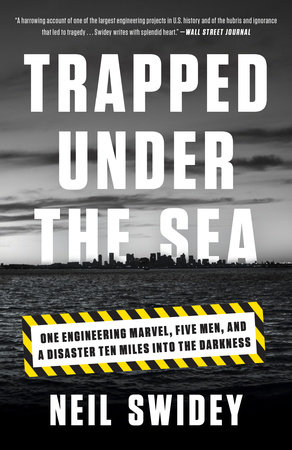Trapped Under the Sea Reader’s Guide
By Neil Swidey


1. Before reading Trapped Under the Sea, had you ever heard of the Boston Harbor clean-up? Were you surprised by Swidey’s description of the harbor before the clean-up?
2. One of the book’s greatest strengths is how well we get to know not only the five divers who took on the toughest assignment of pulling the plugs, but also many of the other key players, from sewer agency boss Doug MacDonald to construction manager Dave Corkum to diving company owners Tap Taylor and Roger Rouleau. With whom did you identify? Whose story surprised you the most?
3. Were you surprised by what you learned about the subculture of commercial divers and the difficulty of their work?
4. Although the beginning of the book is dominated by men, it’s actually two women – detective Mary McCauley and safety director Joan Parker – who play the largest roles after the accident in trying to figure out what went wrong. Is it a coincidence? Or are women somehow better suited to these roles?
5. Given the strikingly different personalities of McCauley and Parker, were you surprised at how closely they bonded? Were you inspired by their tenacity in trying to push for accountability and justice?
6. The “Hail Mary Pass” mission – at the end of the long, expensive Boston Harbor Cleanup Project – proposed to send five commercial divers to the end of a ten-mile tunnel without electricity, light, oxygen or transportation, hundreds of feet below the harbor, and with equipment that had barely been tested and wasn’t recommended for human use. What do you make of the fact that so many seemingly smart people – at levels high and low – signed off on such a risky mission?
7. The Deer Island tunnel was both an engineering marvel and the centerpiece of a multi-billion-dollar massive project that ultimately transformed Boston for the better. Given all the dollars and brain power that went into the project over a decade, why do you think there was there so much pressure to complete the final step – pulling out the plugs – quickly and on the cheap?
8. Even before disaster struck, it was clear to all involved that this was a risky mission. If you were a commercial diver asked to take on this assignment, how do you think you would have reacted? What if it was your spouse or partner who was asked to sign on? Why do you think Hoss, Billy, Tim, Riggs and DJ agreed to the job?
9. Many people hold Harald Grob accountable for \what went wrong in the Deer Island tunnel. Do you agree? Who else do you think shared responsibility for the disaster?
10. What lessons do you think can be learned from Trapped Under the Sea about worker safety, risk management, or organizational behavior for the other large-scale infrastructure projects that make the modern world around us possible?
11. This project attracted some of the best and brightest minds in engineering and construction from around the country. But this story shows that just because you bring top talent together to tackle a huge task doesn’t guarantee a good result. What steps do you think could have been taken early on to better manage the project and avoid the crisis that ultimately forced the five divers to have to risk their lives?
12. Another major focus of the book is non-combat PTSD. Like Hoss, did you initially think that PTSD applied only to veterans who had seen action on the battlefield? Have you ever known anybody who has suffered from it? Like DJ, were you surprised how paralyzing recurring nightmares could be for people who had suffered such searing trauma?
13. When something goes wrong with a large-scale undertaking, the natural impulse is to try to look for the single, giant mistake. Swidey points out, however, that it’s usually a series of small mistakes that align to create disaster, “when the holes in the Swiss cheese line up.” What do you see as the key, small mistakes and bad choices that led to this tragedy?
14. After reading the book, did you come away thinking that the Deer Island disaster could and should have been avoided? Or do you see it as the inevitable outcome of such an ambitious project?
15. Do you look at the infrastructure around us, and the largely anonymous workers who make it possible, any differently after reading this book?
Just for joining you’ll get personalized recommendations on your dashboard daily and features only for members.
Find Out More Join Now Sign In